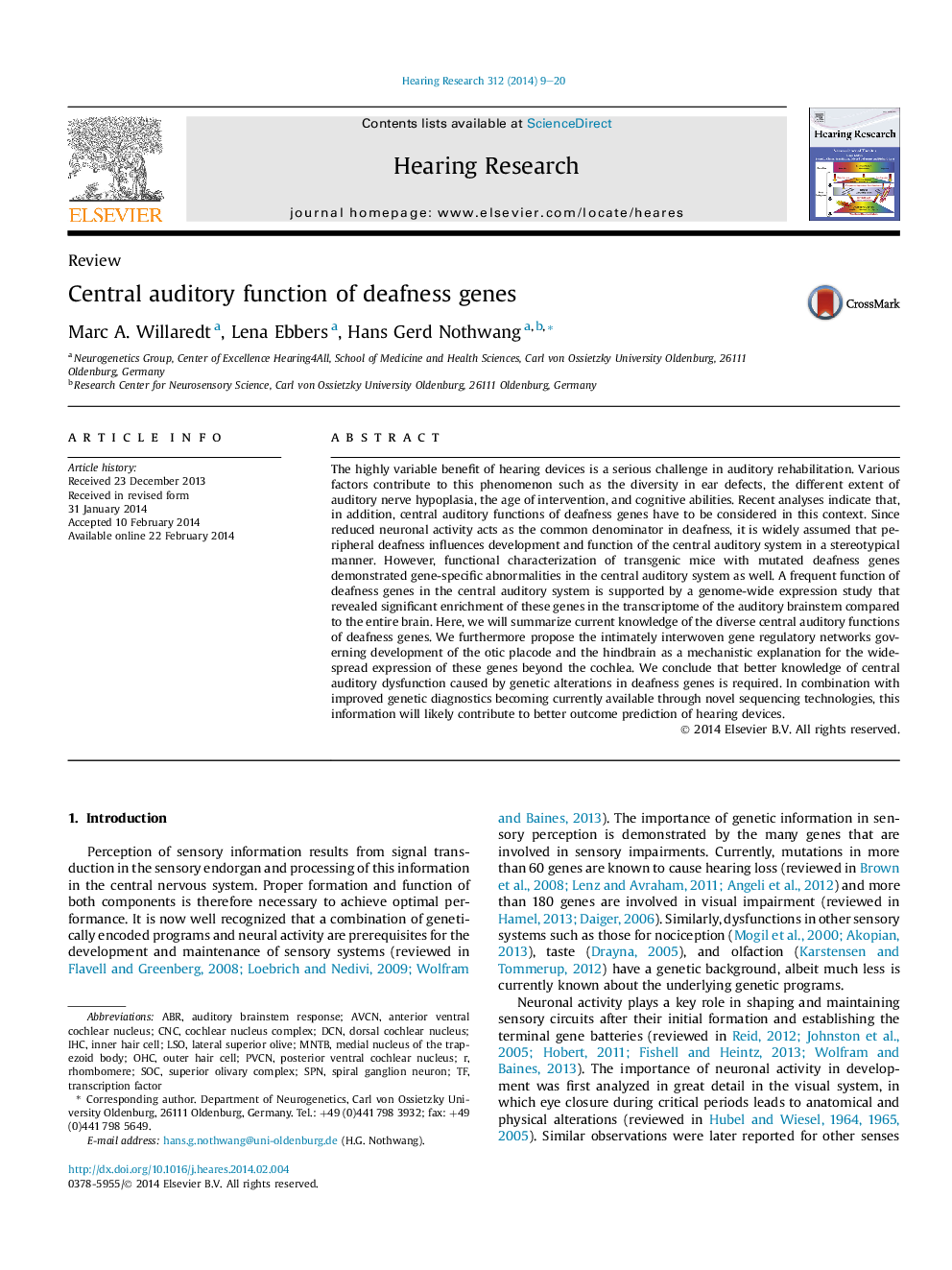| کد مقاله | کد نشریه | سال انتشار | مقاله انگلیسی | نسخه تمام متن |
|---|---|---|---|---|
| 6287389 | 1615588 | 2014 | 12 صفحه PDF | دانلود رایگان |
عنوان انگلیسی مقاله ISI
Central auditory function of deafness genes
ترجمه فارسی عنوان
عملکرد شنوایی مرکزی ژن های ناشنوایی
دانلود مقاله + سفارش ترجمه
دانلود مقاله ISI انگلیسی
رایگان برای ایرانیان
کلمات کلیدی
CNCDCNSPNABRPVCNLSOAVCNOHCMNTBIHC - ایمونوهیستوشیمیRhombomere - رمبومرlateral superior olive - زیتون برتر جانبیouter hair cell - سلول بیرونی موInner hair cell - سلول داخلی داخلیSOC - سیستم روی یک تراشهTranscription factor - عامل رونویسیsuperior olivary complex - مجتمع عالی ایلواریspiral ganglion neuron - نورون گانگلیون مارپیچیposterior ventral cochlear nucleus - هسته حلقوی شکمی خلفیanterior ventral cochlear nucleus - هسته حلقوی شکمی قدامیmedial nucleus of the trapezoid body - هسته مرکزی بدن تراپزیdorsal cochlear nucleus - هسته کچلی پشتیauditory brainstem response - پاسخ شنوایی مغز
ترجمه چکیده
مزایای بسیار متغیر دستگاه های شنوایی یک مشکل جدی در توانبخشی شنوایی است. عوامل متعددی به این پدیده مربوط می شوند مانند تنوع در نقص گوش، اندازه های مختلف هیپوپلیزی عصب شنوایی، سن مداخله و توانایی های شناختی. تجزیه و تحلیل های اخیر نشان می دهد که علاوه بر این، توابع شنوایی مرکزی ژن های ناشنوایی در این زمینه باید در نظر گرفته شود. از آنجایی که فعالیت های عصبی کاهش یافته به عنوان ناشناخته در ناشنوا عمل می کند، به طور گسترده ای فرض می شود که ناشنوای محیطی بر روی توسعه و عملکرد سیستم شنوایی مرکزی به شیوه ای کلیشه ای تاثیر می گذارد. با این حال، ویژگی عملکردی موش های ترانس ژنیک با ژن های ناشنوا جهش یافته، اختلالات خاص ژن را در سیستم شنوایی مرکزی نیز نشان داد. عملکرد مکرر ژن های ناشنوا در سیستم شنوایی مرکزی با استفاده از یک تحقیق بیان عام ژنوم که غنی سازی قابل توجهی از این ژن ها را در ترانسپرتومینوم مغز گوش شنوا در مقایسه با کل مغز تقویت می کند، پشتیبانی می شود. در اینجا، دانش فعلی از ویژگی های متفاوتی شنوایی ژن های ناشنوا را خلاصه می کنیم. علاوه بر این، شبکه های نظارتی ژنتیکی در هم تنیده همکاری می کنند که در راستای توسعه پلاود گوزن و مغز استخوان به عنوان یک توضیح مکانیکی برای بیان گسترده این ژن ها فراتر از حلزون است. ما نتیجه گرفتیم که دانش بهتر از اختلالات شنوایی مرکزی ناشی از تغییرات ژنتیکی در ژن ناشنوا مورد نیاز است. در ترکیب با تشخیص پیشرفته ژنتیکی که در حال حاضر از طریق تکنولوژی توالی جدیدی در دسترس است، این اطلاعات احتمالا به پیش بینی نتایج بهتر دستگاه های شنوایی کمک می کند.
موضوعات مرتبط
علوم زیستی و بیوفناوری
علم عصب شناسی
سیستم های حسی
چکیده انگلیسی
The highly variable benefit of hearing devices is a serious challenge in auditory rehabilitation. Various factors contribute to this phenomenon such as the diversity in ear defects, the different extent of auditory nerve hypoplasia, the age of intervention, and cognitive abilities. Recent analyses indicate that, in addition, central auditory functions of deafness genes have to be considered in this context. Since reduced neuronal activity acts as the common denominator in deafness, it is widely assumed that peripheral deafness influences development and function of the central auditory system in a stereotypical manner. However, functional characterization of transgenic mice with mutated deafness genes demonstrated gene-specific abnormalities in the central auditory system as well. A frequent function of deafness genes in the central auditory system is supported by a genome-wide expression study that revealed significant enrichment of these genes in the transcriptome of the auditory brainstem compared to the entire brain. Here, we will summarize current knowledge of the diverse central auditory functions of deafness genes. We furthermore propose the intimately interwoven gene regulatory networks governing development of the otic placode and the hindbrain as a mechanistic explanation for the widespread expression of these genes beyond the cochlea. We conclude that better knowledge of central auditory dysfunction caused by genetic alterations in deafness genes is required. In combination with improved genetic diagnostics becoming currently available through novel sequencing technologies, this information will likely contribute to better outcome prediction of hearing devices.
ناشر
Database: Elsevier - ScienceDirect (ساینس دایرکت)
Journal: Hearing Research - Volume 312, June 2014, Pages 9-20
Journal: Hearing Research - Volume 312, June 2014, Pages 9-20
نویسندگان
Marc A. Willaredt, Lena Ebbers, Hans Gerd Nothwang,
